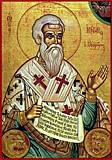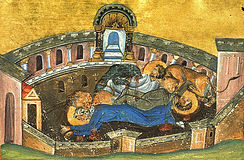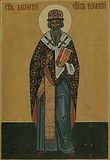

| Previous day | Next day |
| Old Style
January 29
|
Sunday |
New Style
February 11
|
| 36th Sunday after Pentecost. Tone 3. | No fast.
|
![]() Translation of the relics of Hieromartyr Ignatius the God-bearer, bishop of Antioch (107).
Translation of the relics of Hieromartyr Ignatius the God-bearer, bishop of Antioch (107).
Martyrs Romanus, James, Philotheus, Hyperechius, Abibus, Julian, and Paregorius, at Samosata (297). Hieromartyrs Silvanus, bishop of Emesa, the deacon Luke, and the reader Mocius (Mucius) (312). St. Lawrence, recluse of the Kiev Caves and bishop of Turov (1194). Sts. Gerasimus (ca. 1441-1467), Pitirim (1455) and Jonah (1470) bishops of Perm. Synaxis of the Saints of Komi. Synaxis of the Saints of Ekaterinburg. Synaxis of the Saints of Perm. St. Ignatius, bishop of Smolensk (1210). St. Andrew (Rublev), iconographer, of the Spaso-Andronikov Monastery (Moscow) (1430).
Martyrs Sarbelus [Thathuil] and his sister Bebaia, of Edessa (98-138) St. Barsimaeus the Confessor, bishop of Edessa (2nd c.). St. Aphrahates the Persian, hermit, of Antioch (370). St. Gildas the Wise, abbot, of Rhuys, Brittany (ca. 570). St. Severus (Sulpitius I), bishop of Bourges (591). St. Ashot Kuropalates of Tao-Klarjeti, Georgia (829). New Martyr Demetrius of Chios, at Constantinople (1802).
Articles
 St Pitirim the Bishop of PermSaint Pitirim, Bishop of Great Perm, was chosen and consecrated to the See of Perm after the suffering and death of St Gerasimus of Perm. |
 Saint Ignatius, Wonderworker and Bishop of SmolenskSaint Ignatius was the first bishop of Smolensk. |
 Saint Aphraates of PersiaSaint Aphraates, a Persian who came to believe in Christ, disavowed his illustrious lineage and left his pagan countrymen by going to Edessa, and then to Antioch. |











